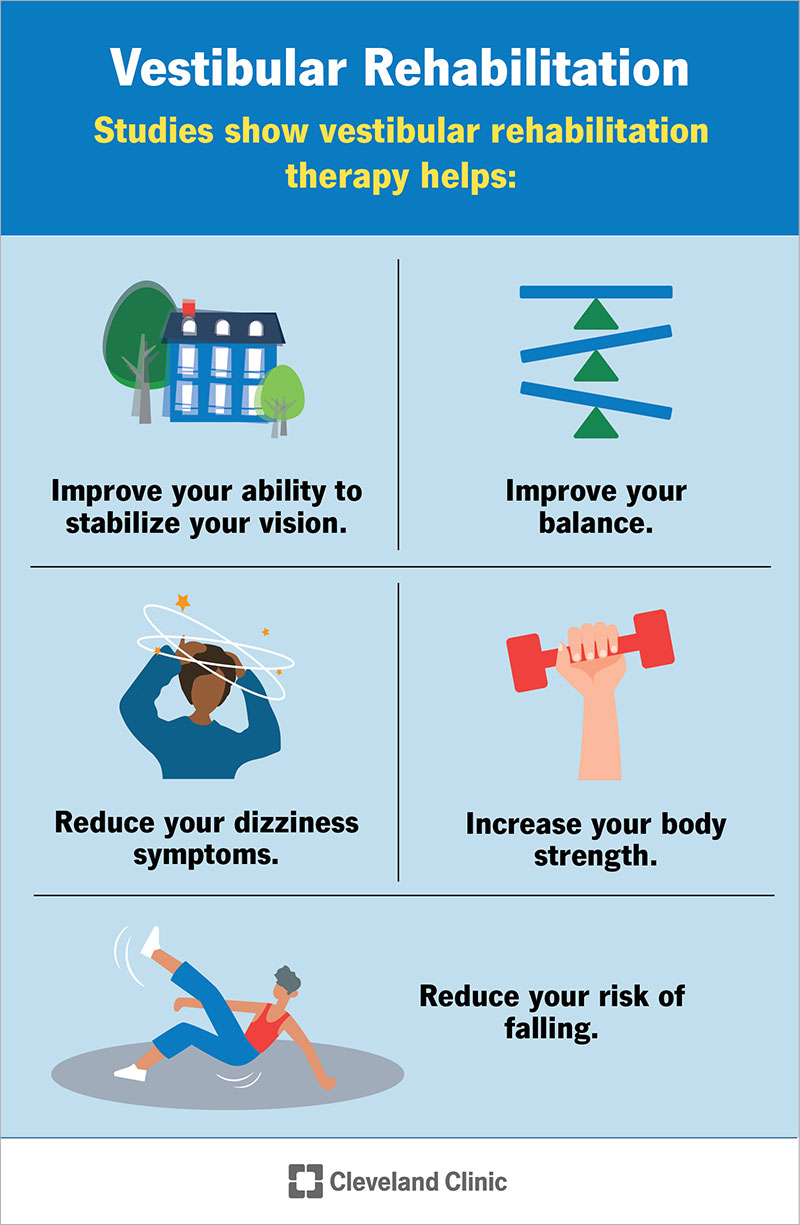Vestibular rehabilitation therapy involves exercises that help you manage dizziness and balance issues (imbalance). This therapy may help people cope with the symptoms of conditions such as vertigo and labyrinthitis.
Advertisement
Cleveland Clinic is a non-profit academic medical center. Advertising on our site helps support our mission. We do not endorse non-Cleveland Clinic products or services. Policy

Vestibular rehabilitation therapy involves exercises that help you manage dizziness and balance issues (imbalance). Vestibular rehabilitation therapy takes time, but it can improve your quality of life.
Advertisement
Cleveland Clinic is a non-profit academic medical center. Advertising on our site helps support our mission. We do not endorse non-Cleveland Clinic products or services. Policy
Dizziness may be a symptom of certain medical conditions that also affect your sense of balance. Dizziness and balance issues may also cause muscle fatigue and headache. Vestibular rehabilitation therapy may help people with conditions including:
Dizziness and balance go hand-in-hand. Vestibular rehabilitation therapy helps you manage dizziness symptoms, including imbalance. To understand how therapy works, it may help to know more about why you may feel very dizzy and how your body manages balance.
Dizziness happens when something affects your sense of spatial orientation. Spatial orientation is your brain calculating the position of your body in relation to your surroundings. When that happens, you may feel woozy or lightheaded. You also may feel unsteady, as if you’ve lost your sense of balance.
Your sense of balance relies on the relationship between your central nervous system (brain) and your sensory system. Your sensory system includes:
Advertisement
Your central nervous system pulls this information together so it can tell your body how to maintain balance. When something interferes with the system’s connection, your central nervous system can’t process information correctly. Vestibular rehabilitation therapy helps restore those connections, ultimately reducing your symptoms of dizziness and imbalance.
You’ll need to have your symptoms evaluated. You may visit an audiologist for a vestibular test battery. These are different tests to evaluate how well the vestibular part of your inner ear is working. A physical therapist will evaluate your balance, your gait (how you walk), your arm and leg strength, and flexibility.
Balance issues and dizziness may affect you in different ways. Your healthcare provider will tailor vestibular rehabilitation therapy to your specific need. They’ll show you how to do specific exercises so you can exercise at home, at your convenience. Therapy may include these exercises:
That depends on your situation. How much therapy you’ll need depends on why you have dizziness or balance issues and how you respond to therapy. Most people have six to eight weekly sessions. Some people may only need one or two sessions. Other people may need several months of ongoing treatment, including doing exercises on their own.
Studies show vestibular rehabilitation therapy helps:
Vestibular rehabilitation therapy doesn’t cause physical risks. There’s always the chance therapy won’t completely resolve your dizziness or balance issues. This is particularly true if you’re not able to do the prescribed exercises on your own.
That depends on your situation. In general, most people who continue doing their exercises have significantly fewer issues with dizziness and balance.
Vestibular rehabilitation therapy rarely causes issues. However, if you’re doing exercises on your own, you should contact your healthcare provider if you have the following symptoms:
It’s disorienting to feel extremely dizzy and lose your sense of balance, even if those sensations go away. Sometimes, dizziness and imbalance are persistent issues that affect your quality of life. Vestibular rehabilitation therapy involves exercises that help you regain your sense of balance and manage dizziness. If you’re concerned about dizzy spells or balance issues, talk to a healthcare provider. They’ll evaluate your situation and, if appropriate, refer you to providers who offer vestibular rehabilitation therapy.
Advertisement
Vertigo, dizziness and balance disorders can make you feel unsteady on your feet. Cleveland Clinic’s experts can craft a treatment plan that works for you.

Last reviewed on 10/16/2022.
Learn more about the Health Library and our editorial process.